Socioeconomic facts and data about rural Ontario
Find historical information about rural Ontario’s population characteristics and key rural economic and labour force indicators.
Overview
Data sources: Most data are estimates from the Ministry of Agriculture, Food and Agribusiness (OMAFA). Staff used relevant publications from Statistics Canada. The covered period depends on the availability of data in the following date ranges:
- Population count data is available from 1966–2021 (by census year). Population age breakdown is available from 1966–2021. All census variables will be updated every 5 years.
- Educational attainment data is available from 1976–2021 census years.
- Immigration data is available from 1971–2021 census years. Immigration data is not available for the 1976 census year.
- Racialized groups data is available from 1996–2021 census years.
- Data on Indigenous peoples (First Nations, Métis, and Inuit) in Canada is available from the 1986 to 2021 census years. Population data for Indigenous peoples is not available for the 2011 census year.
- Household income data is available from 1981–2021 census years.
- Annual labour force characteristics and industry employment data is available from 2011–2024. This data will be updated annually.
- Average annual earnings by industrial sector for rural and urban Ontario are updated annually.
- Estimated annual gross domestic product (GDP) for rural Ontario is available from 2001–2024. This data will be updated annually.
- Rural business count data is available for December 2024. This data will be updated annually.
Disclaimer: OMAFA tries to ensure that the following facts are accurate and complete. However, the user is responsible for any products made or conclusions drawn from this information.
Defining rural Ontario
There are many ways to define rural Ontario. Rural areas are defined differently by the government. This depends on the goals of each program or policy.
For research and analysis, OMAFA defines rural Ontario as all the municipalities and Indigenous communities (First Nations, Metis or Inuit) that are not part of a census metropolitan area. So, urban Ontario covers all municipalities in Statistics Canada’s census metropolitan areas (CMAs). A CMA is an area which has a total population of 100,000 or more and a core population of 50,000 or more. It also includes nearby census subdivisions (CSDs) where 50% or more of the workers commute to the core.
In the 2021 census, 81% of Ontario’s CSDs, or 469 total, were rural (non-CMA). In contrast, 19% of CSDs, which is 108 total, were urban (CMA). Rural Ontario represents 96.2% of Ontario’s land area, or 81% (469) of Ontario’s CSDs were considered as rural (non-CMA).
Figure 1 shows urban and rural areas in Ontario based on the 2021 census boundaries.
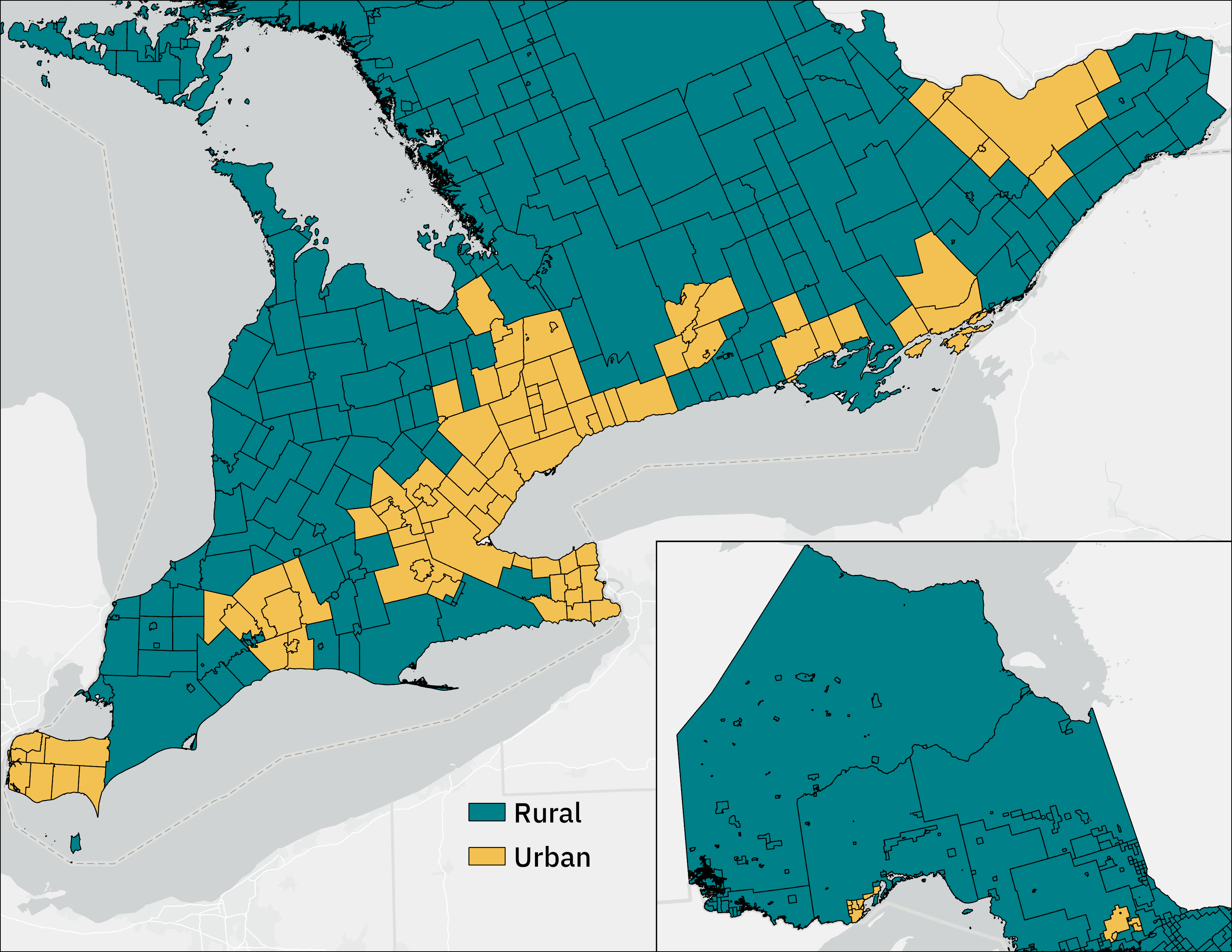
Source: Adapted from Statistics Canada.
For additional information about geographical definitions, please visit Statistics Canada’s Dictionary, Census of Population, 2021.
Overview of demographics
Rural Ontario has many working adults and seniors. Most people have education beyond high school. The number of immigrants is decreasing and, the Indigenous and racialized populations are growing.
Population in most rural communities has been growing, especially during the latest 2 census periods. However, rural CSDs that grow quickly and have more people commuting to a nearby CMA often become urban. This loss of rural CSDs to urbanization biases down rural population growth over time and rural population estimates might not reflect the actual population dynamics in these communities (refer to Demographics for more details). Since 1966, the number of people living in rural areas in Ontario has stayed about the same, but the percentage of the Ontario population living in rural areas has decreased over time because more rural CSDs have become part of a CMA (urban). For example, in 1966, the percentage of the Ontario population living in rural Ontario was 37% (2.6 million out of 7.0 million people). In 2021, it was 17% (about 2.5 million out of 14.2 million people).
In 2021, working-age adults (ages 15–64) made up nearly 67% of rural Ontario's population. Seniors (aged 65 and older) and youth (aged 0–14) make up 24.4% and 15.5% of the population respectively.
Educational attainment in rural Ontario has improved overtime. In 1976, nearly 67% of Ontario’s rural population lacked a high school diploma. Also, 22% had a post-secondary certificate, diploma or degree. By 2021, 19% of people did not have a high school diploma. 59% had a certificate, diploma or degree from post-secondary education.
The share of immigrants in the rural population has been going down over time. In 1971, the percentage of immigrant population was 12.8% (336,155 immigrants). In 2021, it was 8.2% (198,090 immigrants).
Diversity among the rural population has been increasing over time. In 1996, 60,490 rural residents (1.9% of the rural population) identified as racialized. In 2021, 104,070 rural residents, or 4.2% of the rural population, identified as racialized.
The percentage of rural population that is Indigenous has increased from 1.4% in 1986 to 7.5% in 2021.
Overview of economy
Rural Ontario makes large contributions to provincial employment and the GDP.
In 2024, employment in rural Ontario represented 15.4% (1,253,600 jobs) of all provincial employment.
Average annual earnings in urban Ontario were 17% higher than in rural Ontario.
In 2024, rural Ontario’s GDP was estimated to be $116.5 billion (chained 2017 dollars) or 13.3% of Ontario’s total GDP.
In December 2024, 13.9% of Ontario’s businesses were in rural areas. That’s about 268,138 businesses.
Demographics
Population estimates
Statistics Canada changes its CMA boundaries each census year. This helps address the effects of ongoing urban growth. When the population in a census subdivision reaches certain thresholds, it can become a CMA. This means it may lose its rural status. A rural CSD can become urban if more than half of its workers travel to the core of a nearby CMA for work or if it becomes adjacent to it. The expansion of CMA boundaries (urban areas) over time implies a reduction of non-CMAs (rural areas).
Figure 2 shows how Ontario's CMA boundaries grew from 2001 to 2021. It also includes new CMAs added during this period.
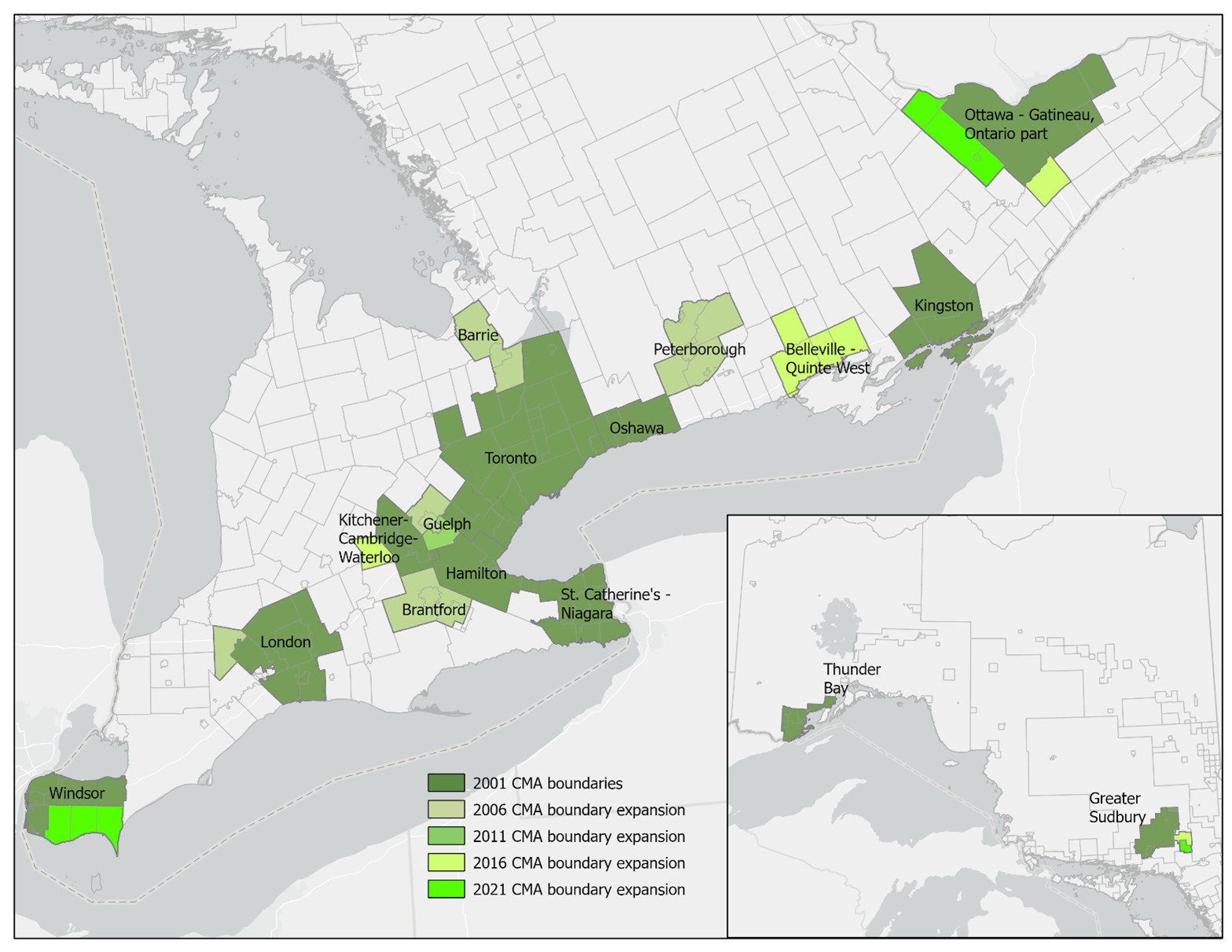
Source: Adapted from Statistics Canada.
Population dynamics
The latest census shows that more rural CSDs grew in population in the 5 years leading to 2021 than at any time since 1996. The number of rural CSDs with growth of 10% or more nearly doubled (Table 1). The detailed CSD data provides evidence of a pandemic related shift in rural population growth.
Conditions in rural communities are reversing decades-long established trends, such as:
- There is evidence of stronger population growth, labour markets, and housing markets.
- Erosion of housing affordability in Toronto has led to more baby boomers retiring. This shift is causing stronger population growth in rural CSDs from 2011 to 2016.
- The pandemic caused remote work to become a viable alternative to traditional work arrangements.
- Net out-migration from urban areas (notably the Toronto CMA) accounts for almost all of the population growth in rural Ontario. It started to accelerate in 2016 and recently hit a record high, supporting rural population growth. Net out-migration from the Toronto CMA might slow after the pandemic. However, since 2020, its resilience shows that rural areas should get ready for strong population growth.
| CSD group | 2021 total | 2021 % total | 2016 total | 2016 % total | 2011 total | 2011 % total | 2006 total | 2006 % total | 2001 total | 2001 % total |
|---|---|---|---|---|---|---|---|---|---|---|
| Total rural CSDs | 469 | 100 | 474 | 100 | 482 | 100 | 486 | 100 | 502 | 100 |
| CSDs with positive growth | 293 | 62 | 250 | 53 | 226 | 47 | 271 | 56 | 210 | 42 |
| CSDs with growth > 10% | 95 | 20 | 55 | 12 | 60 | 12 | 88 | 18 | 65 | 13 |
| CSDs with growth 0–10% | 198 | 42 | 195 | 41 | 166 | 34 | 183 | 38 | 145 | 29 |
| CSDs with negative growth | 145 | 31 | 184 | 39 | 214 | 44 | 175 | 36 | 207 | 41 |
| CSDs with incomplete information | 31 | 6.6 | 40 | 8.4 | 42 | 8.7 | 40 | 8.2 | 85 | 16.9 |
Figures 12 and 13 in the appendix are maps showing changes in population from the census periods 2011–2016 and 2016–2021, respectively. The changes are at the CSD level of geography. CSDs generally correspond to lower-tier municipalities. There is significant variation in population growth among rural CSDs. For example, all CSDs with zero or negative population growth were in rural areas. In contrast, the fastest growing CSDs were also rural.
Heavily populated areas like the Toronto CMA experienced moderate growth (less than 10%).
Find detailed tables about intercensal population change for rural CSDs.
From an overall view, the pandemic's impact on rural population growth isn't as clear. This is mainly due to rural CSDs losing residents to urban areas. Figure 3 highlights the change in aggregate rural population going back to 1966.
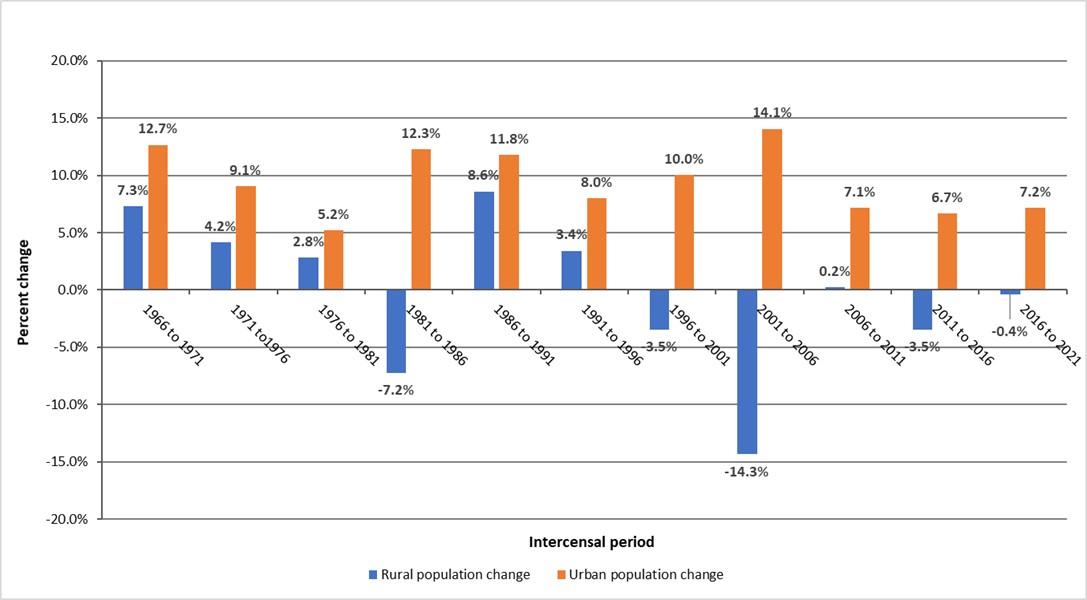
Source: Adapted from Statistics Canada.
Each census year uses updated values from the last census and the current year’s boundaries to calculate the population. Rural population change happens because of shifts within specific boundaries. It also occurs when rural areas are reclassified as urban.
Figures 4 and 5 show population estimates for rural and urban Ontario. They display absolute numbers and percentages by census year. In absolute numbers, the rural Ontario population has remained relatively steady with 2.6 million in 1961 and 2.5 million in 2021. However, as a percentage of the total Ontario population, rural Ontario’s population has decreased from 37% in 1966 to 17% in 2021. By comparison, the number of people living in urban Ontario increased by 169.3% or 7,381,966 during the same period.
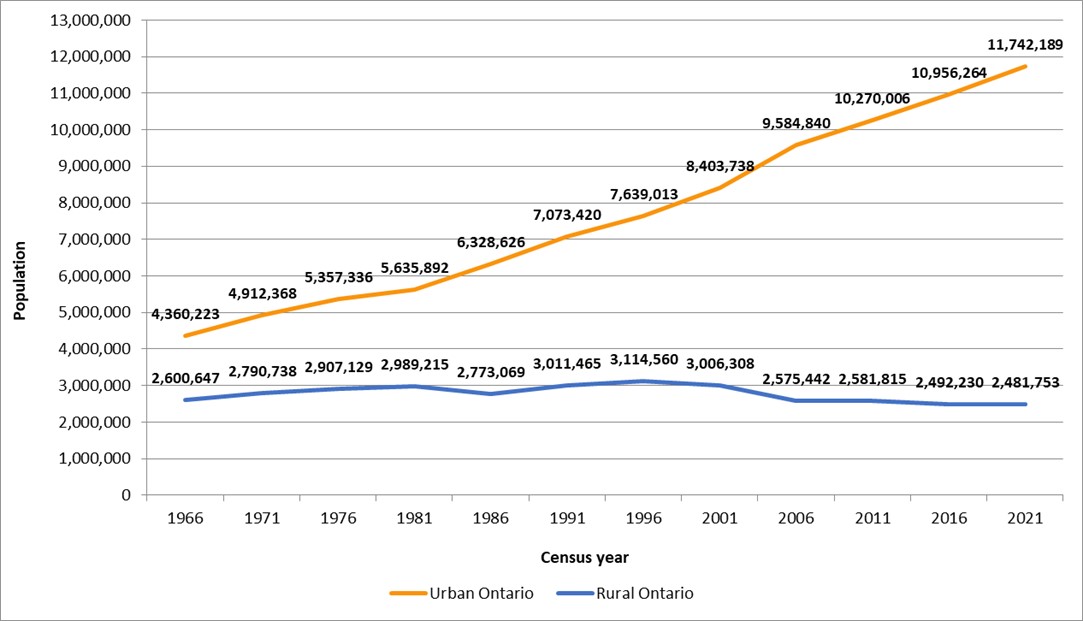
Source: Adapted from Statistics Canada.
Each census year uses updated values from the last census and the current year’s boundaries to calculate the population.
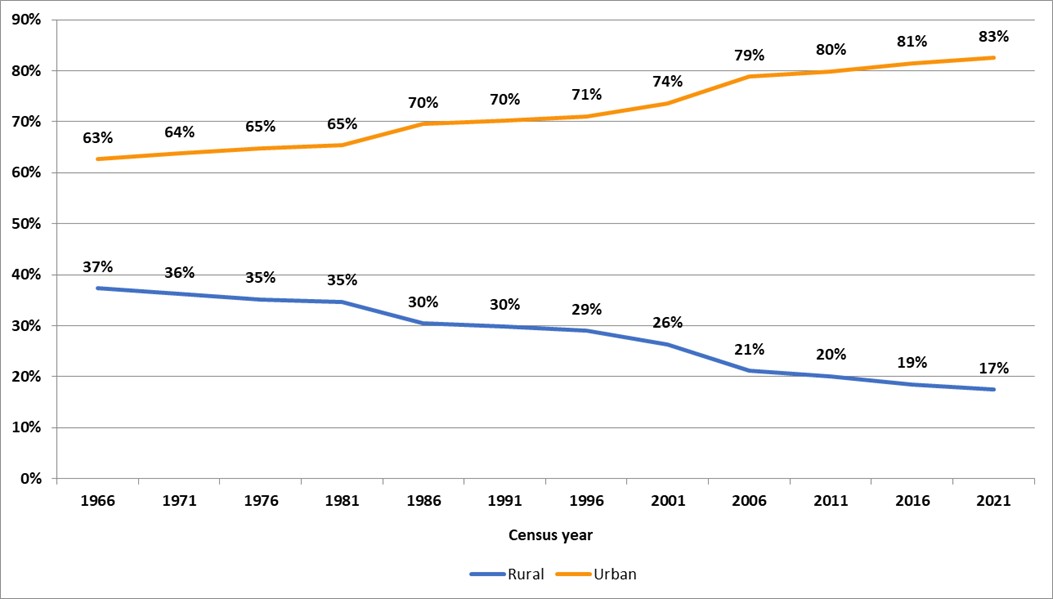
Source: Adapted from Statistics Canada.
Each census year updates the population based on the adjusted values from the last census and the current year's boundaries.
Population change
The percentage of youth in rural Ontario is decreasing while the older population group is increasing over time. Working age population has remained relatively stable.
Table 2 presents the results from the 2021 Census of Population:
- Youth (aged 0–14) in rural Ontario make up 15.5% of the population compared to 15.9% in urban Ontario.
- Working-age adults (aged 15–64) in rural Ontario make up 60.2% of the population compared to 66.8% in urban Ontario.
- Seniors (aged 65 and older) in rural Ontario make up 24.4% of the population compared to 17.3% of the population in urban Ontario.
- Since 2016, rural Ontario has seen a 1.6% decrease in youth, a 4.5% decrease in working-age adults, and a 12.4% increase in seniors.
- Rural Ontario has a larger share of seniors and smaller share of youth and working-age adults than urban Ontario. Likewise, there are notable differences among working-age adults in both rural and urban areas. Rural areas have a higher percentage of older working-age adults than urban Ontario.
Figure 14 in the appendix shows a comparison between rural and urban population by age cohorts.
| Age group | Rural population | Overall % of rural population | Urban population | Overall % of urban population |
|---|---|---|---|---|
| Youth (0–14) | 384,320 | 15.5 | 1,867,475 | 15.9 |
| Working-age (15–64) | 1,493,120 | 60.2 | 7,841,320 | 66.8 |
| Seniors (65 and older) | 604,310 | 24.4 | 2,033,395 | 17.3 |
| Total | 2,481,750 | 100 | 11,742,190 | 100 |
Find tables about rural and urban population characteristics by census year.
Educational attainment
Rural Ontario has shown improvement in educational attainment over time.
As shown in Figure 6, in 2021, half of rural Ontario had post-secondary education. Only 19% of the population lacked a high school diploma. In 1976, almost 67% of rural Ontarians did not have a high school diploma and only 25% of people had post-secondary education. In urban Ontario, the number of people with post-secondary education rose from 34% in 1976 to 59% in 2021. At the same time, those with less than high school education fell from 55% to 14%.
From 1976 to 2021, the percentage of people aged 15–64 with post-secondary education rose. In rural Ontario, it went from 20% to 35%. In urban Ontario, it increased slightly from 25% to 26%. In rural Ontario, the percentage of people aged 15–64 with a university education has risen from 5% to 15%. In urban Ontario, it jumped from 9% to 33%.
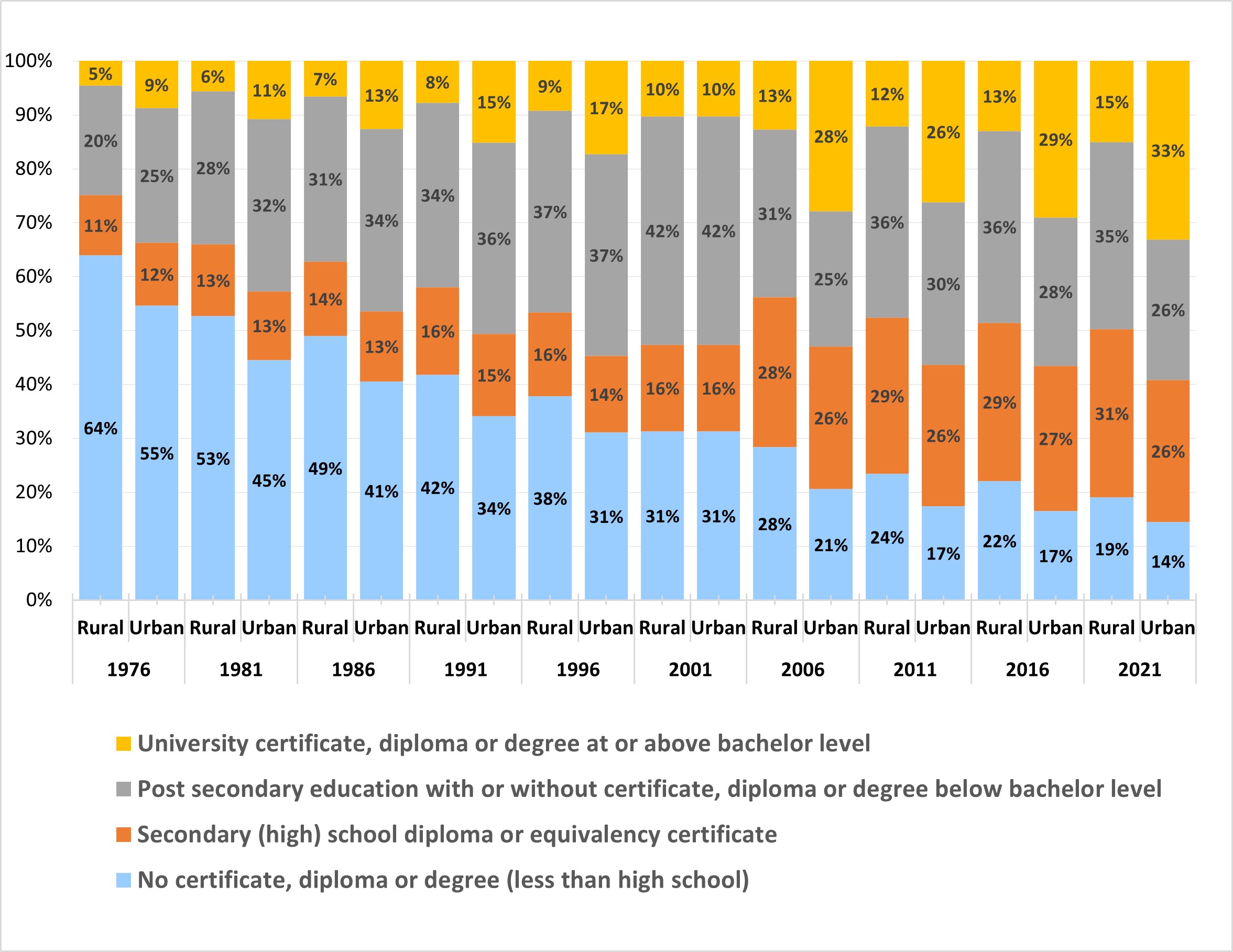
Source: Adapted from Statistics Canada.
Find definitions related to educational attainment.
Find tables about rural (non-CMA) to urban (CMA) educational attainment by census year.
Immigrant population
The percentage of the rural population considered as immigrants has decreased over time, from 12.8% in 1971 to 8.2% in 2021. By comparison, 34.6% of Ontario's urban population in 2021 were considered immigrants.
Over time, a smaller percentage of Ontario immigrants are choosing to live in rural areas. The percentage of Ontario immigrants living in rural areas has decreased from 20% in 1971 (336,155) to 5% in 2021 (198,650).
High immigration and the trend of immigrants moving to big cities explain why Ontario's urban population is growing faster than in rural areas.
| Census year | Rural immigrant population | % of total rural population | Urban immigrant population | % of total urban population |
|---|---|---|---|---|
| 1971 | 336,155 | 12.8 | 1,371,240 | 27.0 |
| 1976 | N/A | N/A | N/A | N/A |
| 1981 | 349,745 | 11.7 | 1,659,830 | 29.5 |
| 1986 | 296,300 | 10.7 | 1,784,900 | 28.2 |
| 1991 | 300,175 | 10.0 | 2,069,000 | 29.3 |
| 1996 | 303,430 | 9.7 | 2,421,060 | 31.7 |
| 2001 | 281,500 | 9.4 | 2,748,575 | 32.7 |
| 2006 | 225,830 | 8.8 | 3,172,895 | 33.1 |
| 2011 | 202,330 | 7.8 | 3,409,035 | 33.2 |
| 2016 | 198,085 | 7.9 | 3,654,060 | 33.4 |
| 2021 | 198,650 | 8.2 | 4,007,940 | 34.6 |
Find definitions related to immigrant status.
Find tables about rural (non-CMA) to urban (CMA) immigrant population by census year.
Racialized groups
The racialized population as a percentage of the rural population has increased over time. In 1996, 60,490 rural residents (1.9% of the rural population) were members of a racialized group. This percentage increased to 4.2% in 2021. By comparison, 40.1% of urban Ontario’s population or 4,713,270 people were considered as racialized population (Table 4).
The majority of Ontario’s racialized population lives in urban areas. In 2021, 198,650 people, representing 2% of Ontario’s racialized population, lived in rural areas.
| Census year | Rural Ontario racialized population | Rural racialized population as a % of rural Ontario population | Urban Ontario racialized population | Urban racialized population as % of Urban Ontario population |
|---|---|---|---|---|
| 1996 | 60,490 | 1.9 | 1,621,555 | 21.2 |
| 2001 | 66,930 | 2.2 | 2,086,115 | 24.8 |
| 2006 | 51,195 | 2.0 | 2,694,010 | 28.1 |
| 2011 | 54,935 | 2.1 | 3,224,630 | 31.4 |
| 2016 | 67,565 | 2.7 | 3,818,020 | 34.8 |
| 2021 | 104,070 | 4.2 | 4,713,285 | 40.1 |
Find definitions related to racialized groups.
Find tables about rural (non-CMA) to urban (CMA) racialized groups by census year.
Indigenous peoples
Indigenous peoples is a collective name for the original peoples of North America and their descendants. Often, Aboriginal peoples is also used (Government of Canada). The Indigenous population in Ontario increased fivefold from 1986–2021. They represented 2.9% of the total Ontario population in 2021. The big rise in the Indigenous population during this time came from:
- a high natural growth rate
- more people choosing to identify as First Nations, Inuit, or Métis
Table 5 shows that the Ontario rural Indigenous population increased over 4 times from 1986 to 2021. It grew from 39,855 people in 1986, which was 1.4% of the rural population, to 184,905 in 2021, making up 7.5% of the rural population.
The percentage of Ontario’s Indigenous population living in rural areas has decreased from 71.7% in 1986 to 45% in 2021.
| Year | Rural Indigenous population | % of overall rural population | Urban Indigenous population | % of overall urban population |
|---|---|---|---|---|
| 1986 | 39,855 | 1.4 | 15,705 | 0.2 |
| 1991 | 47,905 | 1.6 | 23,100 | 0.3 |
| 1996 | 85,570 | 2.7 | 55,955 | 0.7 |
| 2001 | 95,080 | 3.2 | 75,360 | 0.9 |
| 2006 | 122,895 | 4.8 | 111,780 | 1.2 |
| 2011 | N/A | N/A | N/A | N/A |
| 2016 | 175,680 | 7.0 | 198,250 | 1.8 |
| 2021 | 184,905 | 7.5 | 221,680 | 1.9 |
Find definitions related to Indigenous population.
Find tables about rural (non-CMA) to urban (CMA) Indigenous population by census year.
Average household income
Total income for households means the money earned from various sources by all members before taxes and deductions. This is measured over a specific time period. The monetary receipts included are those that tend to be of a regular and recurring nature.
Figure 7 contrasts the average household income between rural and urban areas from 1981–2021. Average household income in rural areas has increased from $22,522 in 1981 to $98,468 in 2021. In 2021, rural household income was 18% lower than urban income.
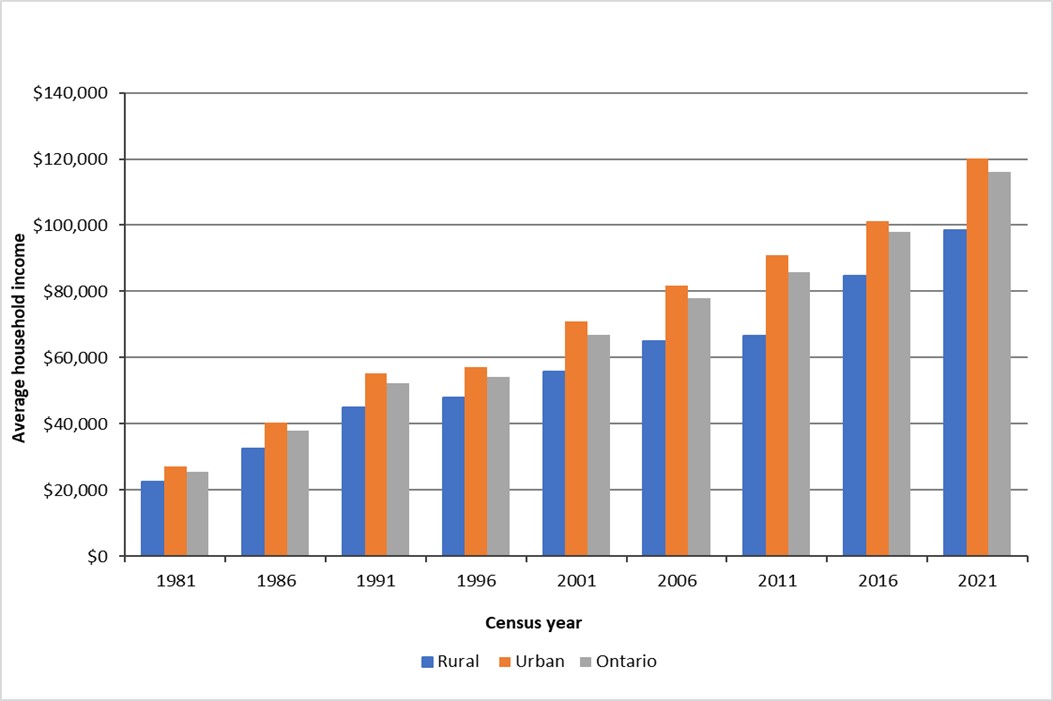
Source: Adapted from Statistics Canada.
Find definitions related to household income.
Economy
Employment
Figure 8 shows number of people employed in rural and urban Ontario from 2011–2024.
During the period from 2011 to 2024, employment in rural Ontario has increased by 126,000 jobs, from 1.1 million in 2011 to 1.25 million in 2024 (an 11.2% increase). In comparison, employment in urban Ontario has increased by 24.9% (1.37 million jobs) during the same period. Rural areas grow slower, mainly because of urbanization. As rural CSDs grow quickly, they become CMAs and lose their rural status over time.
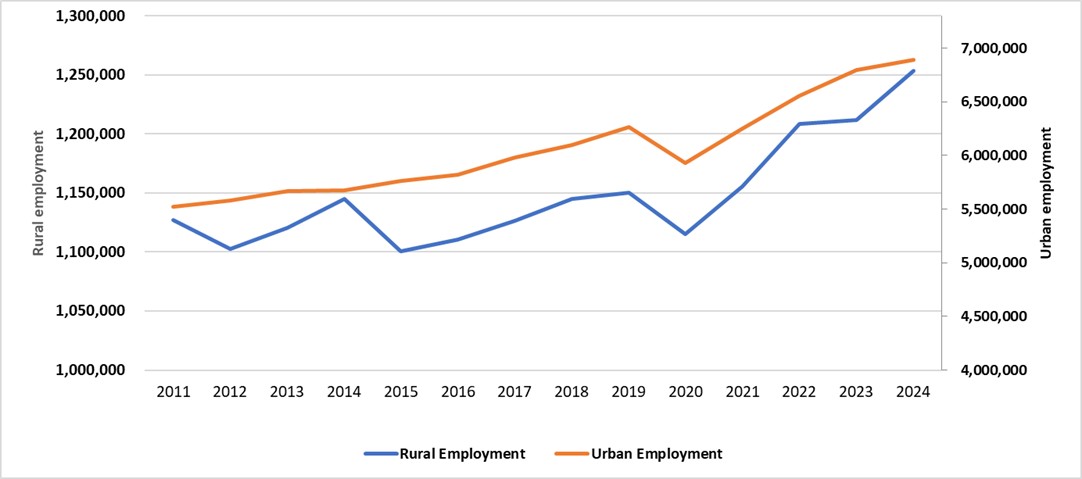
Source: Adapted from Statistics Canada.
Employment in services-producing and goods-producing sectors
Jobs in rural Ontario’s service sector are growing faster than in the goods sector (Figure 9). The services-producing sector has produced about 70% of total rural jobs from 2011 to 2024. During this time, jobs grew from 793,600 to 884,400, which is an 11.4% increase. In urban Ontario, the services-producing sector makes up about 80% of all jobs. It grew by 27.2%, adding 1.2 million jobs during that time.
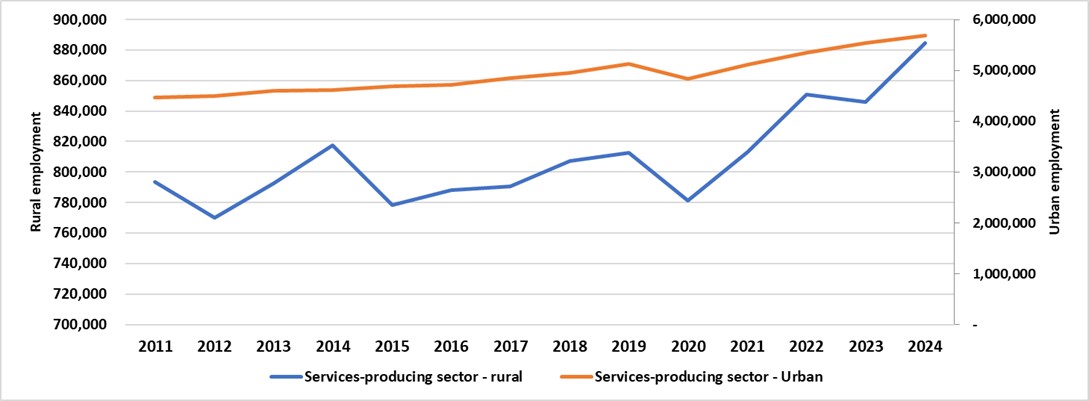
Source: Adapted from Statistics Canada.
Figure 15 in the appendix shows the top 7 services-producing industries:
- wholesale and retail trade
- health care and social assistance
- educational services
- professional, scientific and technical services
- public administration
- accommodation and food services
- other services (except public administration
Employment in rural Ontario’s goods-producing sector has shown slower growth than the services-producing sector (Figure 10). This sector has kept about 30% of total rural jobs from 2011 to 2024. Jobs grew from 333,300 to 368,900, which is a 10.7% rise. The goods-producing sector in urban Ontario makes up about 20% of total urban jobs. It grew by 14.9%, adding 57,700 jobs during this time.
As shown in Figure 16 in the appendix, the manufacturing, construction and agriculture industries generates approximately 25% of total rural employment.
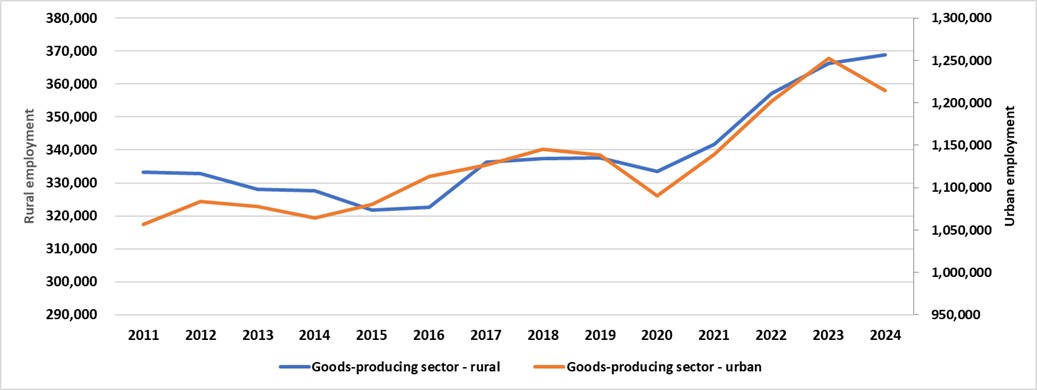
Source: Adapted from Statistics Canada.
Find data tables about Ontario rural and urban employment.
Average annual earnings by industrial sector in rural and urban Ontario
People working in rural Ontario generally earn less than those who work in urban areas.
In 2024, the average annual earnings for rural employees were $54,061. Urban employees earned $63,170 on average, which is about 17% higher than rural earnings (Figure 11).
The only 3 industries where the estimated wages for people working in rural Ontario were higher in 2023 than those working in urban Ontario are:
- management of companies and enterprises
- utilities
- educational services
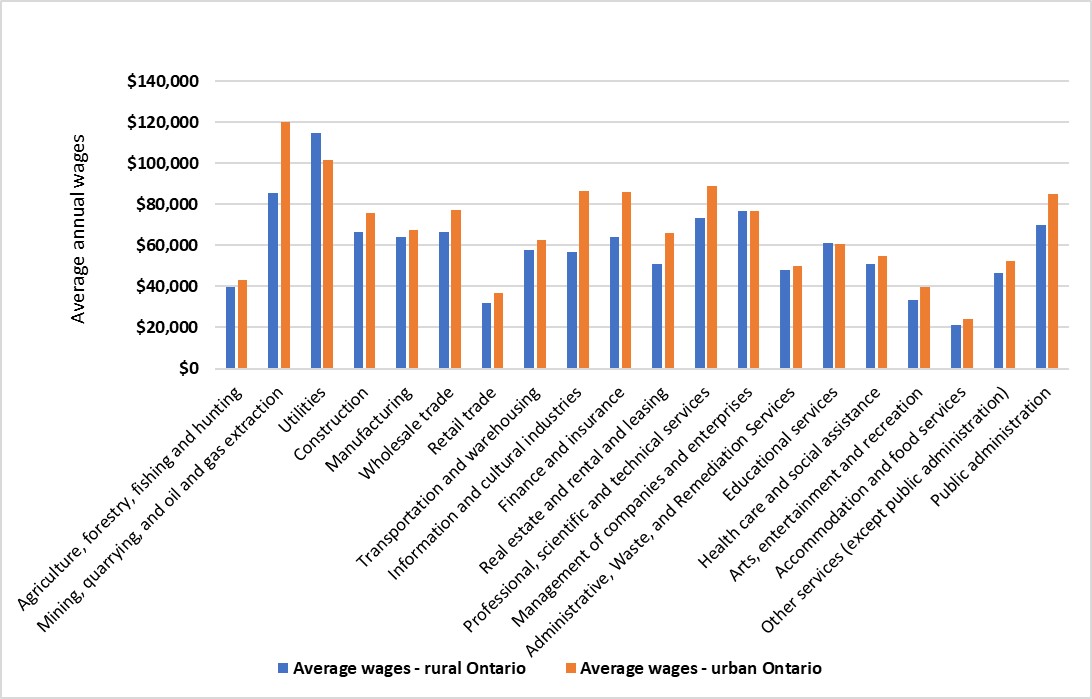
Source: Lightcast (2025). Input-Output model. It is based on data from Statistics Canada's National Symmetric Input-Output table (2022), National Household Survey commuting flows, Canadian Business Patterns, and several Emsi in-house data sets.
Rural Ontario GDP estimate
The estimated 2024 real GDP for rural Ontario was $116.5 billion or 13.3% of Ontario’s GDP. The 2024 GDP OMAFA’s estimates for rural Ontario are derived from Statistics Canada’s GDP estimates for non-CMA areas which are only available with a lag of 3 years (up to 2020) (Statistic Canada’s Tables: 36-10-0402-01, 36-10-0423-01 and 36-10-0468-01). Rural Ontario’s 2023 GDP was estimated by taking the 2021 percentage of Ontario’s GDP that rural areas contributed, which was 13.3%. This percentage was applied to the latest provincial GDP estimate from May 2024.
Find data tables about Ontario rural Ontario GDP estimates.
Rural and urban businesses
In December 2024, an estimated 268,138 businesses (13.9% of Ontario businesses) were in rural Ontario. 1,668,120 businesses were in urban Ontario. Table 6 shows the number and percentage of business classified by number of employees in both rural and urban areas respectively.
Non-employers or indeterminate businesses, which have no employees, make up 70% and 76% of all businesses in Ontario, respectively. Micro businesses (1–4 employees) make up 16.3% of rural businesses and 16.5% of urban ones. Small businesses (1–99 employees) represent 29.1% of rural businesses and 25.2% of urban businesses in Ontario. Medium and large businesses combined account for less than 1% of all businesses in rural and urban Ontario, respectively.
| Business size category | Rural business | % of overall rural businesses | Urban business | % of overall urban businesses | Ontario business | % of Ontario businesses |
|---|---|---|---|---|---|---|
| Non-employer or indeterminate | 188,802 | 70.41 | 1,270,321 | 76.15 | 1,462,555 | 75.54 |
| Small (1–99 employees) | 77,962 | 29.08 | 420,421 | 25.20 | 498,383 | 25.74 |
| Medium (100–500 employees) | 1,226 | 0.46 | 8,067 | 0.48 | 9,293 | 0.48 |
| Large (500 or more employees) | 148 | 0.06 | 1,326 | 0.08 | 1,474 | 0.08 |
| Total | 268,138 | 13.85 | 1,668,120 | 86.15 | 1,936,258 | 100.0 |
Find data tables about rural (non-CMA) to urban (CMA) business counts for rural Ontario.
Appendix
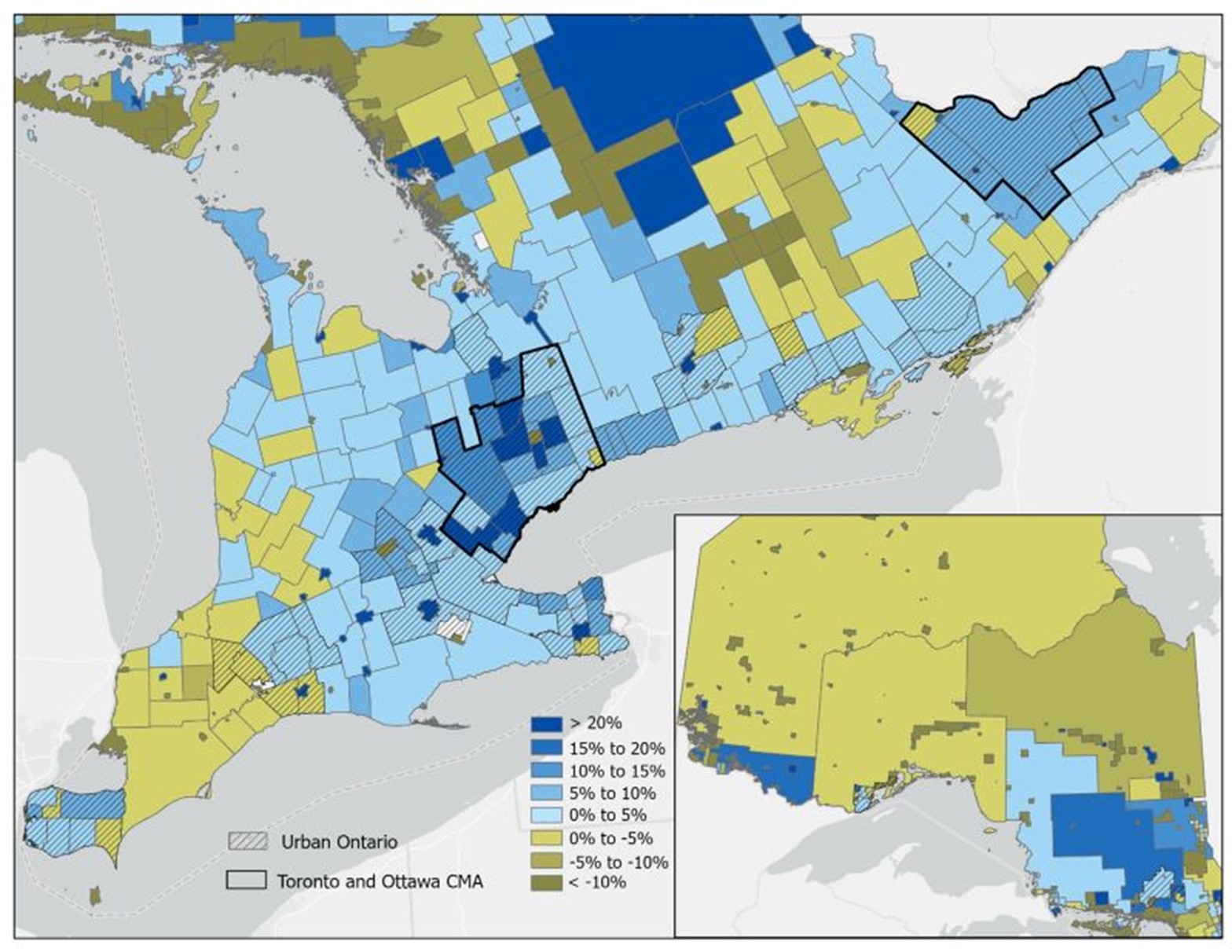
Source: Adapted from Statistics Canada.
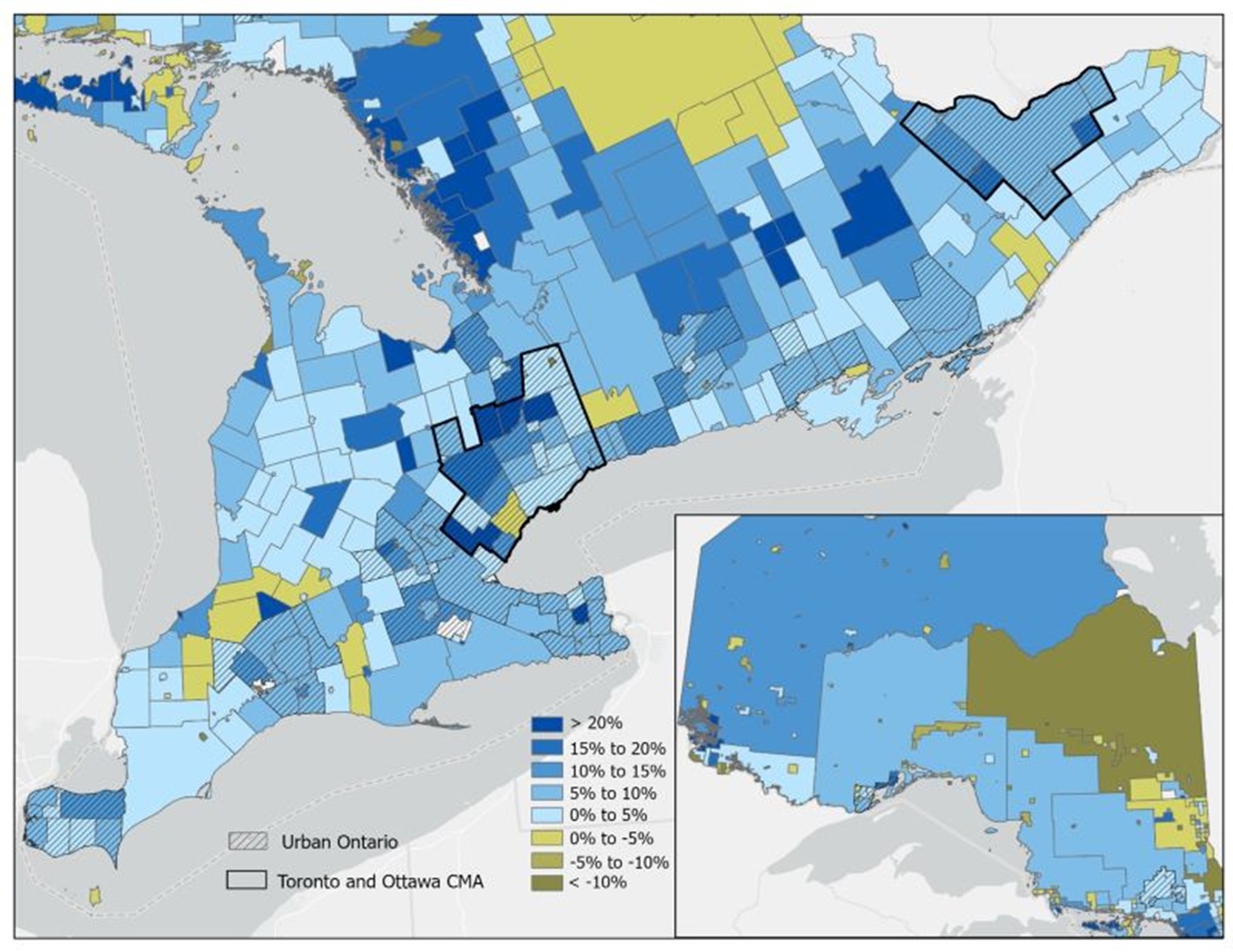
Source: Adapted from Statistics Canada.
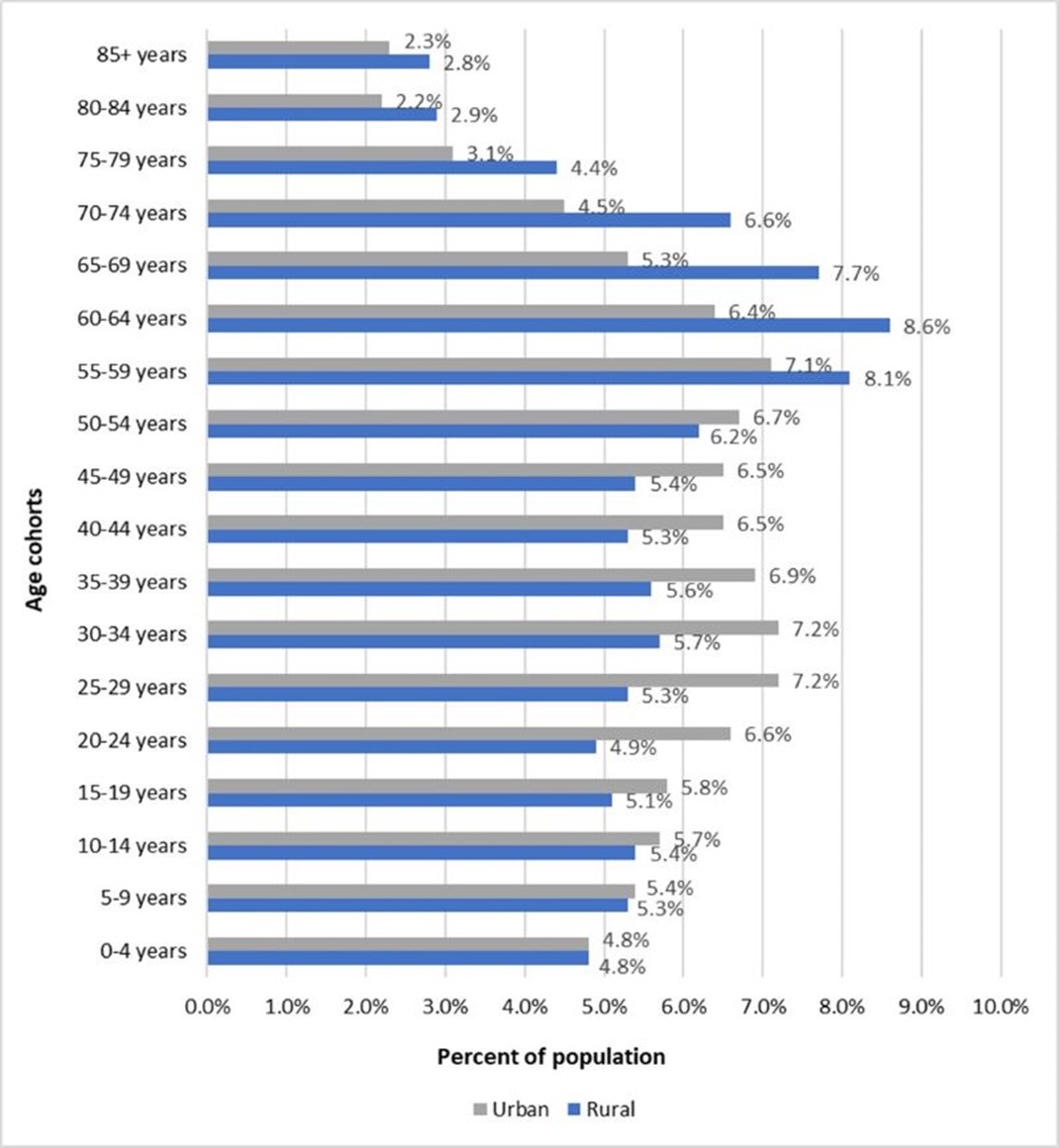
Source: Adapted from Statistics Canada.
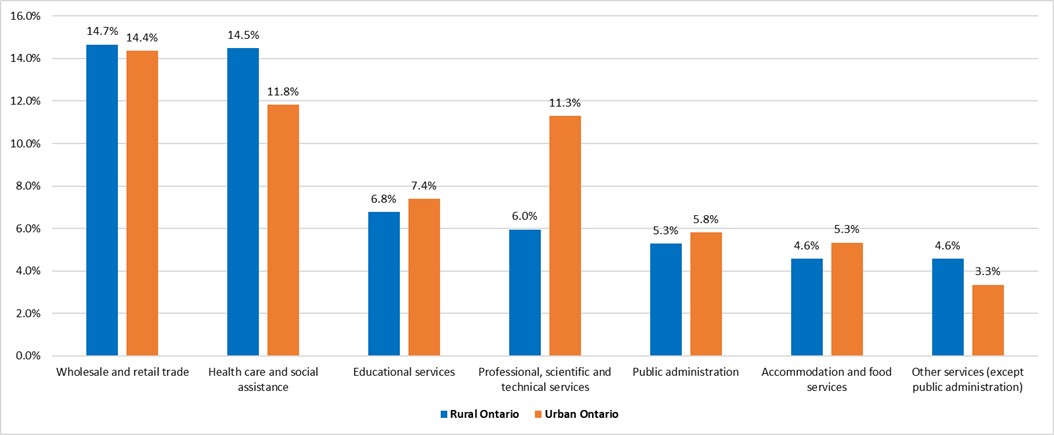
Source: Adapted from Statistics Canada.
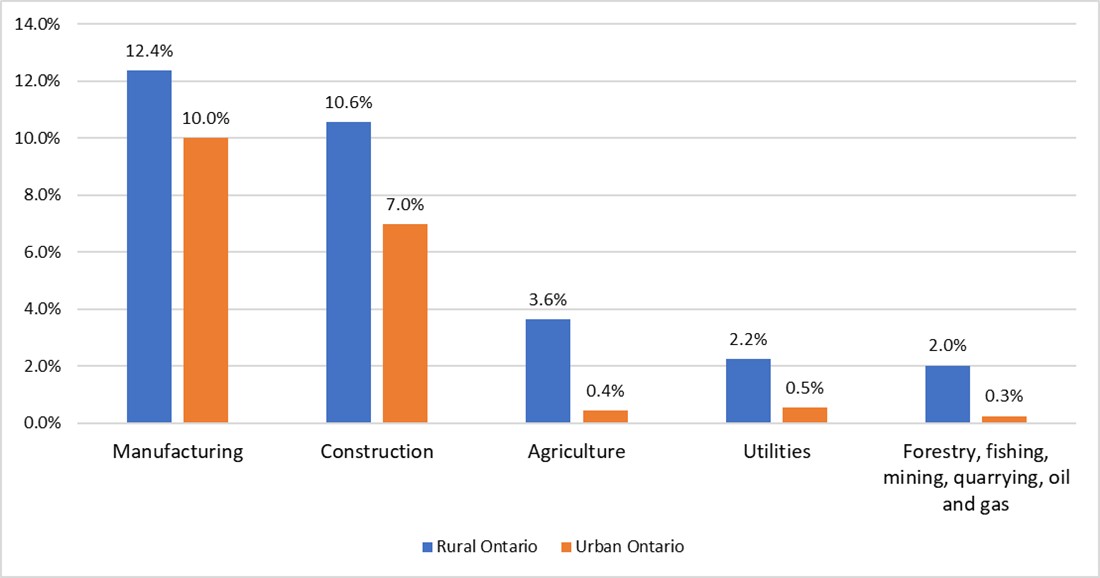
Source: Adapted from Statistics Canada.